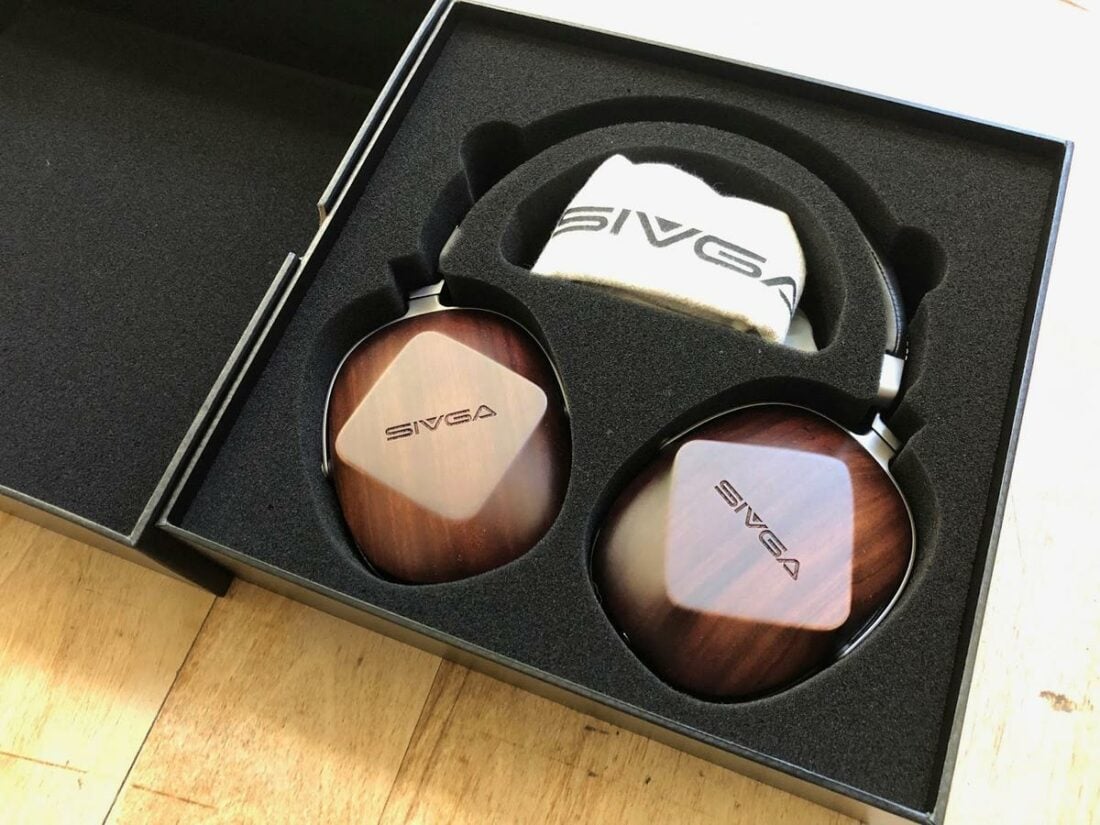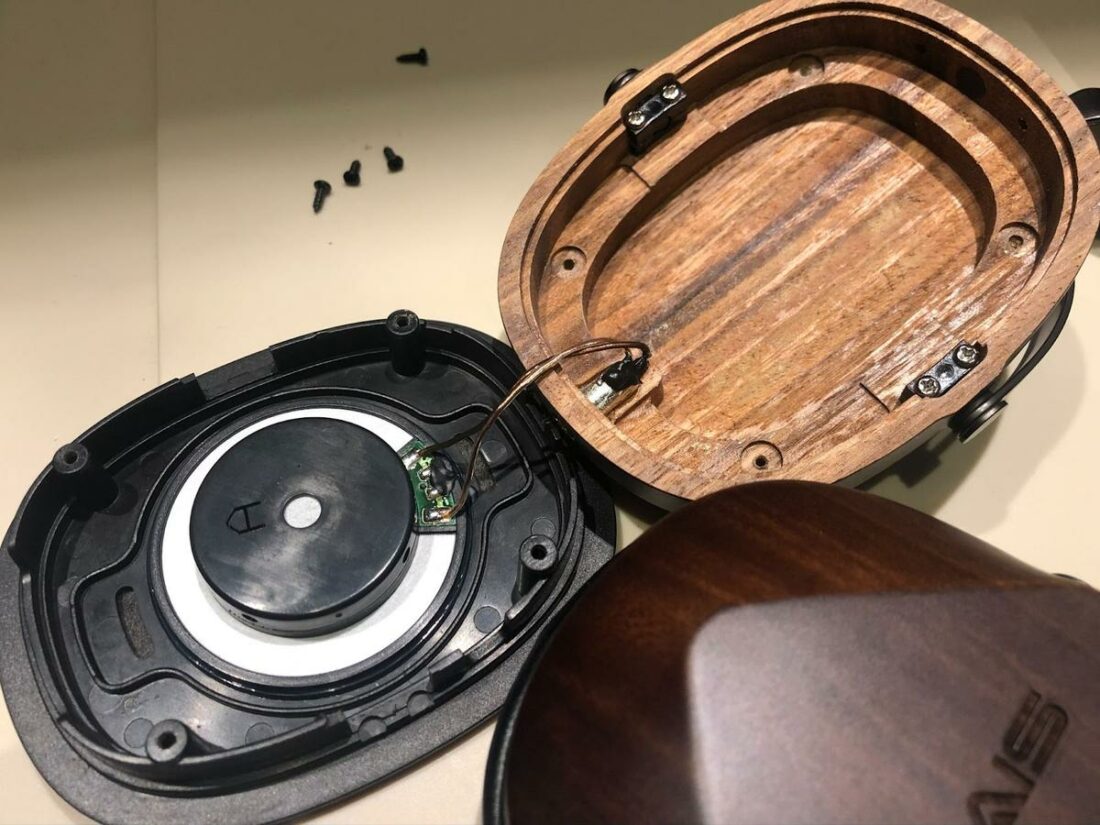Beautifully crafted wooden songbirds, or just a decoy?
Sivga has made a name for producing affordable wooden-cupped headphones constructed at a level far beyond their modest price tags. Sivga’s headphones are also known for having somewhat divisive sound signatures as they are not all tuned to the same curve, and each have their own unique sound.
The Oriole are the successor to the Robin (aka SV021), are priced about USD $50 higher, and have a similar package, style, and shape. However, the Oriole promise a more refined and improved sound.
- Impressive build quality at this price point
- Well-made cable
- Great passive isolation
- A solid choice for commuters
- Clear and detailed sound
- Wide soundstage for closed-back cans
- Lightweight
- The cable is a bit long for portable use
- Pleather pads are small for bigger ears and heads
- The headband could be better padded
- Upper midrange presence can be harsh at higher volumes
I recently reviewed the far less catchily-designated SV023 (with no corresponding bird name) and was impressed by their relatively ‘safe’ and well-mannered sound. The SV023 are about 2.5 times more expensive than the Oriole and sport the brand’s higher-end headband and 300 Ohm dynamic drivers.

On paper, the Oriole are far closer to the Robin, sharing 50mm, 32 Ohm drivers and more straightforward construction. Both are priced between USD $150-$200 and share very similar looks. Do the Oriole differentiate themselves enough to fly on their own?
Put on your sun hat, grab your favorite bird book and binoculars, and let us see if this bird has the wings to fly.
Company Overview
Dongguan Sivga Electronic Technology Co., Ltd., established in 2016, is located in Dongguan, China. Their corporate vision is to “become a leading company in hifi headphone industry [sic] in China and even in the world.”
Formed by experienced industry engineers and audio pros, Sendy/Sivga strives to break “the barrier of product performance to set new standards and continuing to create [a] magical experience for customers.” They focus on craftsmanship, quality control, and marrying sound quality with beautifully made products.
Technical Specifications
- Form: Closed-back, Over-ear
- Drivers: 50mm dynamic driver
- Impedance (Ohm): 32 Ohm ±15%
- Sensitivity (dB): 108dB ±3dB
- Frequency Response (Hz): 20 Hz – 20 kHz
- Removable Cable: Y
- Source Jack: 3.5mmTRS
- Cup/Shell Jack: 2x 2.5mm
- Mic: N
- Weight (g): 280g

Packaging
I’ve become used to the higher-end, sister-brand Sendy Audio and Sivga products that come bundled with a distinctively shaped hard case and beautiful braided balanced cable. For the Oriole (and Robin), the bundle is leaner.
Slide open the foam-lined, black cardboard box, and you’ll find the Oriole, hemp bag, cable, and 3.5-6.35mm adapter nestled in foam.

In the box
- Oriole headphones
- 3.5mm to dual 2.5mm cable (2m)
- 3.5mm – 6.35mm adapter
- Hemp cloth storage bag

Cable
While the basic functionality remains the same as the higher-end Sivga and Sendy balanced cables, the Oriole’s bundled cable is a touch less flashy. Rather than a woven braid, the 2-meter cable is sheathed in black paracord.
The cable is fairly thin but is supple and soft to the touch. The connectors and y-split are constructed from black metal with gold contacts. The 3.5mm TRS connector has a metal spring strain relief, and the dual 2.5mm connectors are easy to differentiate with white ‘L’ and ‘R’ indicators and red/green colored bands.
It’s all bundled up with a Velcro tie.
The Velcro cable tie will come in handy to bundle up excess if using the Oriole with a portable source. Two meters is too long for a mobile cable, but I appreciate the length to make the Oriole more suitable for desktop or home use.
Sivga makes great cables!

Design
The Oriole, like the Robin before them, are available in two color schemes, either light brown wood with silver metal bits and tan colored pads or, as reviewed, dark brown cups with gunmetal colored yokes and black pads. Both options are distinct and attractive.
The cups are milled from Rosewood, which Sivga claims “is the first choice for balanced and high resolution sound, and no fatigue for long time listening.” Sivga uses a five-axis CNC machine to cut the cups and sand, polish, and coat them by hand. The final finish is a piano gloss clearcoat with a laser-engraved logo.
It’s this attention to detail that elevates the Oriole.
The Oriole differs from the Robin as the cups have a flattened diamond shape surface, rather than circular, and can rotate 180 degrees to sit flat on a desk or while around a neck. There are three small vent holes on the top edge of each cup, and the gold 2.5mm jacks are centered flush in the bottom.

When I handed her the Orioles, I asked her what price range she thought they might belong to. Her guess was five times more than reality. That is high praise for Sivga’s construction.
The sturdy metal yokes retract into the band with a solid-feeling 12-step click mechanism.

Comfort
Fortunately, the Oriole weigh in at a mere 280g, as the faux-leather padding on the band and ear cups is fairly minimal and would not be sufficient for heavier cans. The headband is less comfortable than the comfort strap design included with the SV023 or Sivga offerings.
The pleather, memory foam earpads are approximately 20mm deep with an internal oval cavity measuring 45mm x 65mm. Roomy enough for my smallish ears, however, those with more prominent appendages may run into fit issues. The Robin come with larger, more plush pads.

Internals
The 50mm dynamic driver is advertised as being developed in-house. Further details are scarce beyond the 108dB sensitivity and 32 Ohm impedance ratings. It’s fair to consider that the Oriole are designed for portable usage as their efficient nature can be driven easily by most sources.
The driver is mounted to a plastic baffle with two small, felt-covered vents into an unfinished wood cup without internal dampening material.

Sivga Oriole Sound
As noted, the Oriole are easy to drive to sufficient volume from most anything, including an Apple iPhone dongle. Some improvement in dynamics comes from using more powerful sources, but purchasing an amplifier to power the Oriole is not necessary.
Their closed design provides a relatively high level of passive isolation, making the Oriole a good choice for commuters that don’t want or need active noise cancellation (ANC). It’s easy to get immersed in the Oriole and block out the outside world, even at relatively low volume levels.
The Sivga website describes the Oriole as “balanced, natural, and accurate” with “moderate bass, smooth mids, fresh and exquisite treble.”
For the most part, Sivga delivers on these promises.

Last week I was reviewing the TOTL, open-backed Focal Utopia (2022). These, unsurprisingly, sound spectacular and set the standard for headphone performance. It’s an interesting process to recalibrate my ears and listen to what a pair of headphones costing approximately 25 times less can deliver.
The Oriole’s overall sound is relatively balanced, although a lift in the upper midrange around 2.5 kHz can add an aggressive, in-your-face tonality. The detail is quite good, giving the impression of clarity and instrument separation.
For relatively small and shallow closed-back headphones, the soundstage is fairly roomy, and the Oriole don’t sound as closed in as many headphones seem to in this price range. Voices and instruments extend laterally, and the Oriole manage to avoid a closed-in, center-of-the-head listening experience.
The mid-bass is more controlled than I expect in closed-back consumer cans, and things remain blessedly free of boominess and bloat. Coupled with the energetic midrange and extended treble frequencies, the Oriole feel nimble and detailed. It’s just the upper-midrange peak that stands out and creates a bit too much presence for my tastes with some music.
With a song like “Waves” by Bahamas, the male vocals jump to the forefront and the very low-end thumps with respectable authority.
Bass
Bassheads should likely pass on the Oriole, as the low-end isn’t tuned to brain-shaking levels. Instead, they exhibit a restrained demeanor, with a relatively flat mid-bass response. This tuning goes a long way in keeping the mid-range lean and controlled.
Punch is there when required, and the result is a natural, quick response that is quite different from today’s tendency to boost those lower frequencies unnaturally. As a result, the Oriole are perhaps better suited to rock, folk, and other less electronically driven genres.
Midrange
The Oriole dip around 300 Hz and steadily climb until they hit a 2.5 kHz peak. The lower midrange is somewhat recessed, and the upper midrange jumps out. Unfortunately, this signature is a bit fatiguing at louder volumes, so the Oriole sound best at moderate volume.
It’s a balancing act that gives the vocals presence and clarity, but when it goes too far, can sound a touch harsh. The Oriole’s lean signature does well with fast, energetic music.
Looking for clarity and energy? The Oriole deliver in spades. Those wanting a more lush and full sound signature will likely not gravitate to the Oriole’s personality.
Horns take the forefront, while kickdrums sit back further in the mix.
Treble
Articulate, natural, and lively, the treble takes a back seat after the upper midrange and adds to the clarity and splash without becoming sibilant. I find the treble spot-on for a pair of closed-back headphones in this range.

Where to Buy
Conclusion
With the Oriole, Sivga again delivers a pair of headphones with terrific build quality and a potentially divisive sound signature. There’s no arguing that at the USD $200 price point, few (if any) contenders show such good looks, high-end materials, and meticulous construction.
The combo of effective passive isolation, small size, lightweight, high-efficiency, and rotating earcups make the Oriole an excellent choice for commuters and portable listing.
I’m a big fan of how the Oriole look and feel. Comfort is good and the bundled cable is excellent.
I’m a little more on the fence with the sound signature, although there is lots to like. The Oriole’s clarity and soundstage are outstanding for a pair of headphones in this category. I appreciate that Sivga doesn’t simply model every pair to the pervasive Harman target.
However, to my ears, how the Oriole handles the upper midrange can accentuate those frequencies a bit too much and become a touch aggressive. Depending on the music choice, the Oriole can become fatiguing for long-term listening.
Suppose you are shopping for a new budget pair of closed-back headphones. In that case, I suggest giving the Oriole a listen and seeing if their particular flavor tickles your auditory taste buds.

How is it in comparison to the SV021 Robin?
Unfortunately I don’t have the Robin on hand to directly compare.
How do the Sivga oriole compare to the Meze 99 Classics …Thanks
The Oriole have a harsher upper midrange, while the 99 Classics have a more loose low end. Build quality is better with the 99 Classics.